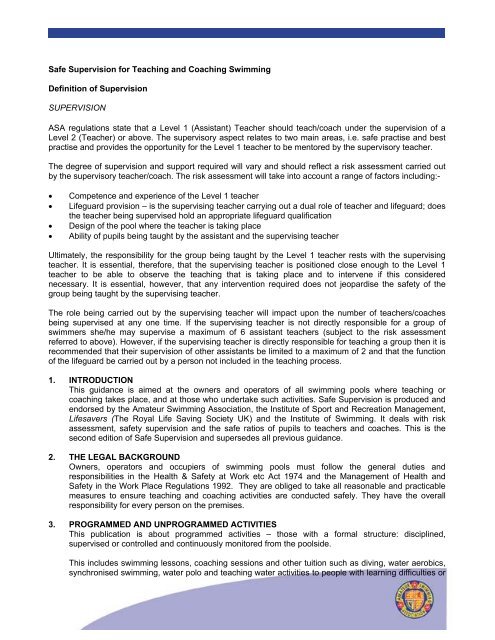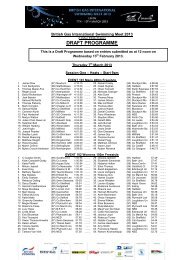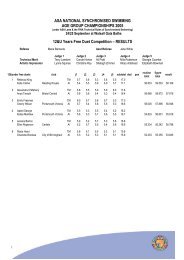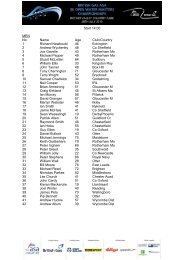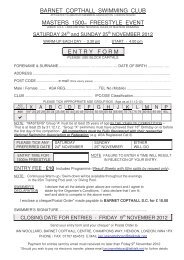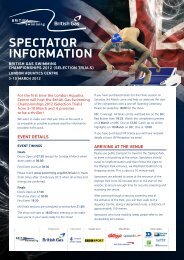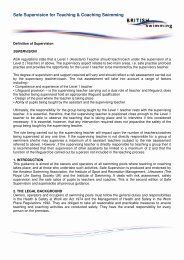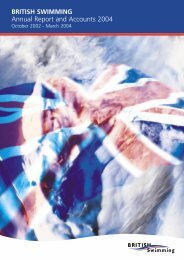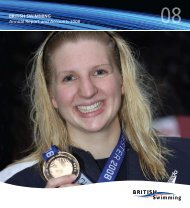Safe Supervision for Teaching and Coaching Swimming - Swim Wales
Safe Supervision for Teaching and Coaching Swimming - Swim Wales
Safe Supervision for Teaching and Coaching Swimming - Swim Wales
You also want an ePaper? Increase the reach of your titles
YUMPU automatically turns print PDFs into web optimized ePapers that Google loves.
<strong>Safe</strong> <strong>Supervision</strong> <strong>for</strong> <strong>Teaching</strong> <strong>and</strong> <strong>Coaching</strong> <strong><strong>Swim</strong>ming</strong><br />
Definition of <strong>Supervision</strong><br />
SUPERVISION<br />
ASA regulations state that a Level 1 (Assistant) Teacher should teach/coach under the supervision of a<br />
Level 2 (Teacher) or above. The supervisory aspect relates to two main areas, i.e. safe practise <strong>and</strong> best<br />
practise <strong>and</strong> provides the opportunity <strong>for</strong> the Level 1 teacher to be mentored by the supervisory teacher.<br />
The degree of supervision <strong>and</strong> support required will vary <strong>and</strong> should reflect a risk assessment carried out<br />
by the supervisory teacher/coach. The risk assessment will take into account a range of factors including:-<br />
• Competence <strong>and</strong> experience of the Level 1 teacher<br />
• Lifeguard provision – is the supervising teacher carrying out a dual role of teacher <strong>and</strong> lifeguard; does<br />
the teacher being supervised hold an appropriate lifeguard qualification<br />
• Design of the pool where the teacher is taking place<br />
• Ability of pupils being taught by the assistant <strong>and</strong> the supervising teacher<br />
Ultimately, the responsibility <strong>for</strong> the group being taught by the Level 1 teacher rests with the supervising<br />
teacher. It is essential, there<strong>for</strong>e, that the supervising teacher is positioned close enough to the Level 1<br />
teacher to be able to observe the teaching that is taking place <strong>and</strong> to intervene if this considered<br />
necessary. It is essential, however, that any intervention required does not jeopardise the safety of the<br />
group being taught by the supervising teacher.<br />
The role being carried out by the supervising teacher will impact upon the number of teachers/coaches<br />
being supervised at any one time. If the supervising teacher is not directly responsible <strong>for</strong> a group of<br />
swimmers she/he may supervise a maximum of 6 assistant teachers (subject to the risk assessment<br />
referred to above). However, if the supervising teacher is directly responsible <strong>for</strong> teaching a group then it is<br />
recommended that their supervision of other assistants be limited to a maximum of 2 <strong>and</strong> that the function<br />
of the lifeguard be carried out by a person not included in the teaching process.<br />
1. INTRODUCTION<br />
This guidance is aimed at the owners <strong>and</strong> operators of all swimming pools where teaching or<br />
coaching takes place, <strong>and</strong> at those who undertake such activities. <strong>Safe</strong> <strong>Supervision</strong> is produced <strong>and</strong><br />
endorsed by the Amateur <strong><strong>Swim</strong>ming</strong> Association, the Institute of Sport <strong>and</strong> Recreation Management,<br />
Lifesavers (The Royal Life Saving Society UK) <strong>and</strong> the Institute of <strong><strong>Swim</strong>ming</strong>. It deals with risk<br />
assessment, safety supervision <strong>and</strong> the safe ratios of pupils to teachers <strong>and</strong> coaches. This is the<br />
second edition of <strong>Safe</strong> <strong>Supervision</strong> <strong>and</strong> supersedes all previous guidance.<br />
2. THE LEGAL BACKGROUND<br />
Owners, operators <strong>and</strong> occupiers of swimming pools must follow the general duties <strong>and</strong><br />
responsibilities in the Health & <strong>Safe</strong>ty at Work etc Act 1974 <strong>and</strong> the Management of Health <strong>and</strong><br />
<strong>Safe</strong>ty in the Work Place Regulations 1992. They are obliged to take all reasonable <strong>and</strong> practicable<br />
measures to ensure teaching <strong>and</strong> coaching activities are conducted safely. They have the overall<br />
responsibility <strong>for</strong> every person on the premises.<br />
3. PROGRAMMED AND UNPROGRAMMED ACTIVITIES<br />
This publication is about programmed activities – those with a <strong>for</strong>mal structure: disciplined,<br />
supervised or controlled <strong>and</strong> continuously monitored from the poolside.<br />
This includes swimming lessons, coaching sessions <strong>and</strong> other tuition such as diving, water aerobics,<br />
synchronised swimming, water polo <strong>and</strong> teaching water activities to people with learning difficulties or
physical disabilities. Teachers <strong>and</strong> coaches of these <strong>and</strong> similar activities should hold appropriate,<br />
recognises teaching/coaching qualifications.<br />
Managing Health & <strong>Safe</strong>ty in <strong><strong>Swim</strong>ming</strong> Pools, a guidance document from the Health <strong>and</strong> <strong>Safe</strong>ty<br />
Commission <strong>and</strong> Sport Engl<strong>and</strong>, indicates that programmes sessions, under certain circumstances,<br />
may have fewer lifeguards that unprogrammed sessions.<br />
4. SAFE SUPERVISION<br />
Managing Health & <strong>Safe</strong>ty in <strong><strong>Swim</strong>ming</strong> Pools recommends that everybody providing lifeguard<br />
functions – whether lifeguards or teachers <strong>and</strong> coaches – should hold an appropriate lifesaving award<br />
or qualification. A lifeguard may not be required in programmed sessions when the teaching <strong>and</strong><br />
coaching of swimming is taking place. In these situations, where the risk is limited due to the nature of<br />
the activity <strong>and</strong> the degree of control exercised, the teacher or coach may provide the safety cover.<br />
However they should have the appropriate lifesaving competencies, which include rescue skills,<br />
Cardio-Pulmonary Resuscitation (CPR), <strong>and</strong> have knowledge of relevant aspects of the Pool <strong>Safe</strong>ty<br />
Operating Procedures (PSOP).<br />
Where teachers are directly responsible <strong>for</strong> supervising the swimming pool, per<strong>for</strong>ming the role of<br />
lifeguards in an unprogrammed pool session, they too should have the competencies <strong>and</strong> skills<br />
required of a lifeguard in those circumstances.<br />
Where programmed sessions are the only activity in the pool, teachers or coaches may provide the<br />
safety cover providing they hold an appropriate ASA swimming teaching/coaching qualification or<br />
equivalent plus:<br />
• A current Lifesavers National Pool Lifeguard qualification, any equivalent award, or<br />
• The National Rescue Award <strong>for</strong> <strong><strong>Swim</strong>ming</strong> Teachers <strong>and</strong> coaches, or<br />
• The Rescue Test <strong>for</strong> <strong><strong>Swim</strong>ming</strong> Teachers <strong>and</strong> Coaches<br />
The National Rescue Award <strong>for</strong> <strong><strong>Swim</strong>ming</strong> Teachers <strong>and</strong> Coaches is jointly recognised by the<br />
Amateur <strong><strong>Swim</strong>ming</strong> Association, Lifesavers, the Institute of <strong><strong>Swim</strong>ming</strong> <strong>and</strong> the Institute of Sport <strong>and</strong><br />
Recreation Management as being appropriate <strong>for</strong> programmed activities.<br />
Where the pool is in shared use <strong>and</strong> clearly divided between programmed <strong>and</strong> unprogrammed<br />
swimming activities, suitably qualified teachers <strong>and</strong> coaches may take responsibility (both <strong>for</strong><br />
lifeguard cover <strong>and</strong> teaching <strong>and</strong> coaching) – but only <strong>for</strong> the programmed area of the pool <strong>and</strong> within<br />
the agreed ration of pupils to teacher <strong>and</strong> coach.<br />
Where the shared use is not clearly defined between programmed <strong>and</strong> unprogrammed activities<br />
supervision must be provided in accordance with the pool’s normal operating procedures.<br />
Helpers <strong>and</strong> support teachers who are not qualified can play a valuable role in supporting qualified<br />
staff responsible <strong>for</strong> the safe delivery of programmed pool activities.<br />
5. THE ROLE OF RISK ASSESSMENT<br />
The circumstances <strong>and</strong> design of swimming pools vary greatly: a st<strong>and</strong>ard solution to cover every<br />
pool is not practicable, so risk assessment is the essential first step – <strong>for</strong> any pool, <strong>and</strong> certainly when<br />
setting up teaching or coaching. Risk assessment must:<br />
• Identify hazards<br />
• Assess risks<br />
• Indicate, as far as is practicable, the measures required to control these hazards <strong>and</strong> risks.<br />
These control measures should then be incorporated in written pool safety operating procedures
(PSOP) which consists of a normal operating plan (NOP) <strong>and</strong> an emergency action plan (EAP). When<br />
preparing these, management should consult fully with swimming teachers, coaches, schoolteachers<br />
<strong>and</strong> others who bring groups to the pool.<br />
The PSOP must clearly state the safety <strong>and</strong> supervisory requirements <strong>for</strong> all activities in the pool.<br />
Coaches <strong>and</strong> teachers must be familiar with <strong>and</strong> practised in the relevant aspects of the PSOP. This<br />
helps to ensure the consistency of st<strong>and</strong>ards.<br />
6. SAFETY FACTORS IN RISK ASSESSMENT<br />
Each pool will have unique features that make particular dem<strong>and</strong>s on safety. This section highlights<br />
six important factors.<br />
Pool design<br />
The suitability of the general design of the pool area <strong>for</strong> teaching <strong>and</strong> coaching includes:<br />
• Shape <strong>and</strong> blind spots<br />
• Special water features such as sprays, inlets <strong>and</strong> wave machines<br />
• Blind spots resulting from the position of features or equipment<br />
• Glare, reflection, lighting <strong>and</strong> noise<br />
Depth<br />
Its importance in relation to the ability <strong>and</strong> height of the pupils include:<br />
• The depth <strong>and</strong> extent of shallow water areas<br />
• The extent of deep water areas<br />
• The pool floor profile, in particular sudden changes in depth<br />
• The possibility of being able to segregate the shallow water area (e.g. roping off <strong>and</strong> using a<br />
boom)<br />
Water quality<br />
Two factors need to be considered:<br />
• The temperature of the pool water (<strong>and</strong> the air) in respect of com<strong>for</strong>t – bearing in mind pupils’<br />
size, age <strong>and</strong> physical ability<br />
• Clarity of the pool water<br />
Pool organisation<br />
The arrangements of the lesson must be considered:-<br />
• Who has the responsibility <strong>for</strong> the pool<br />
• Is there exclusivity of use?<br />
• Is there shared use with other activities?<br />
• If use is shared what are the implications? (e.g. lifeguarding responsibilities)<br />
Staffing<br />
The skills <strong>and</strong> experience of staff <strong>and</strong> the ratio of pupils to teachers/coaches are important;<br />
consideration needs to be given to:<br />
• The qualification <strong>and</strong> number of teachers, coaches <strong>and</strong> lifeguards required<br />
• The skill of teachers, coaches <strong>and</strong> lifeguards<br />
• The degree of support <strong>and</strong> help provided by appropriate helpers, including parents, school<br />
assistants <strong>and</strong> auxiliaries<br />
Pupils <strong>and</strong> ability<br />
The factors to be considered include:<br />
• The age of pupils
• The range of their swimming ability. This should be known by the teacher or coach <strong>and</strong> each<br />
new pupil should be checked at the first lesson, in shallow water<br />
• The use of flotation aids<br />
• The ability of pupils to comprehend instructions including their comm<strong>and</strong> of the language in<br />
which the lesson is taught<br />
• Any physical disabilities or learning difficulties<br />
7. TEACHING FROM THE POOLSIDE<br />
In the situation where the teacher has responsibility <strong>for</strong> groups comprising more than two pupils the<br />
recommended teaching position is from the side of the pool as this provides the best position to<br />
oversee the whole group in terms of safety <strong>and</strong> to provide appropriate feedback on the per<strong>for</strong>mance<br />
of each person in the group.<br />
This does not preclude a teacher being in the water to assist pupils either on a 1:1 or 1:2 basis or as<br />
an assistant to the class teacher. In fact <strong>for</strong> groups of more than two pupils a fully qualified teacher on<br />
the poolside supported by an assistant in the water may be ideal.<br />
It is recognised, however, that in some circumstances the teacher will have assessed the risk <strong>and</strong><br />
may feel it is more appropriate to teach from within the water. For groups of more than two pupils this<br />
should only be considered after carrying out a risk assessment giving careful consideration of all the<br />
potential factors.<br />
Factors to take into account include those identified above particularly pool depth, ability of pupils <strong>and</strong><br />
the use of flotation aids. At all times the teacher must be able to clearly see all pupils <strong>and</strong> be close<br />
enough to provide physical support should this be required. In this way it may be practicable to<br />
supervise up to four pupils, ratios greater than this should not be considered unless additional helpers<br />
are available in the water.<br />
8. PUPIL TEACHER RATIOS<br />
It is recommended that in the vast majority of cases encountered, pupil: teacher ratios should not<br />
exceed 20:1 – <strong>and</strong> in some cases should be less than that. These ratios are based upon safety<br />
requirements <strong>and</strong> not the criteria <strong>for</strong> teaching. The paragraph given later headed Exceptions deals<br />
with those routine circumstances in which the 20:1 ration can be exceeded.<br />
Having taken into account the safety <strong>and</strong> other guidelines already dealt with, the recommendations<br />
here should be helpful in determining actual rations <strong>for</strong> programmes swimming activities. The ratios<br />
given are <strong>for</strong> pupils in the water. Where the teacher is also responsible <strong>for</strong> pupils not in the water but<br />
on the poolside, then the ratios may need to be smaller or appropriate action taken as indicated in the<br />
paragraph given later headed Exceptions.<br />
The ratios – not to be exceeded<br />
Adult <strong>and</strong> Child classes 12:1<br />
That is, up to twelve pairs (one adult <strong>and</strong> one child) to each teacher. For the purposes of this<br />
document the term child refers to – a child, less than 5 years of age<br />
Non-swimmers <strong>and</strong> beginners 12:1<br />
Young children, normally of primary school age or adults being introduced to swimming. If more than<br />
this number is being taught, other adults may be used to help the teacher/coach – see later<br />
paragraph headed Exceptions.<br />
Improving swimmers 20:1<br />
<strong>Swim</strong>mers of similar ability to each other who can swim at least 10 metres competently <strong>and</strong> unaided
on their front <strong>and</strong> back. It is recommended that the lesson be confined to an area of the pool where<br />
pupils are not out of their depth.<br />
Mixed ability groups 20:1<br />
Pupils with a range of ability (from improver st<strong>and</strong>ard to competent swimmers) but where the least<br />
able <strong>and</strong> least confident are working well within their depth. <strong>Swim</strong>mers technique, stamina <strong>and</strong> deep<br />
water experience should be considered.<br />
Competent swimmers 20:1<br />
Those swimmers who can swim at least 25 metres competently <strong>and</strong> unaided on front <strong>and</strong> back, <strong>and</strong><br />
can tread water <strong>for</strong> two minutes.<br />
Competitive swimmers 30:1<br />
Training only, with very competent swimmers<br />
Synchronised swimming 20:1<br />
In water over 1.8m deep the ratio should be considered in relation to swimming competence <strong>and</strong> the<br />
activity taking place. The teacher or coach must be able to rescue from the deepest part of the pool<br />
floor or be accompanied by a suitably qualified pool lifeguard.<br />
Water Polo 20:1<br />
Training only<br />
Aerobics in deep water 20:1<br />
Pupils must be water confident <strong>and</strong> either wear an appropriate buoyancy aid or be competent<br />
swimming in deep water<br />
Aerobics in shallow water 30:1<br />
Pupils must be restricted to water within which they can safely st<strong>and</strong> <strong>and</strong> all must be able to st<strong>and</strong> up<br />
from lying in the water on their front or back<br />
Diving – beginners <strong>and</strong> improver divers 12:1<br />
Divers of similar ability who are com<strong>for</strong>table <strong>and</strong> confident in deep water<br />
Diving – competitive divers 15:1<br />
This refers to the training of competent divers. A competent diver is one who is able to swim<br />
competently <strong>and</strong> is able to per<strong>for</strong>m a safe <strong>for</strong>ward dive <strong>and</strong> backward dive from the poolside,<br />
demonstrating control <strong>and</strong> awareness of both themselves <strong>and</strong> other users. The same applies from<br />
whichever diving board they choose to use<br />
<strong>Swim</strong>mers with disabilities 8:1<br />
(With an appropriate number of helpers). Each situation must be considered independently as people<br />
with disabilities do not <strong>for</strong>m a homogenous group. Care must be taken to ensure that there are<br />
sufficient helpers in the water to provide a 1:1 ratio <strong>for</strong> those needing constant support <strong>and</strong> a<br />
sufficient number of other helpers to provide the degree of support dem<strong>and</strong>ed by the range of<br />
disabilities within the group. There are national organisations <strong>for</strong> specific disabilities from whom<br />
further guidance may be obtained.<br />
Exceptions<br />
Organisational dem<strong>and</strong>s will sometimes make a teaching ratio within 20:1 virtually impossible. In<br />
these circumstances a qualified <strong>and</strong> skilled teacher can adopt a number of strategies to help with the<br />
management of the group. For example, another responsible person on the poolside, who is<br />
competent to recognise <strong>and</strong> respond to a pupil in difficulty, may provide the necessary supervision. In<br />
a school this could be an interested parent, a teaching auxiliary or a sixth <strong>for</strong>m student training <strong>for</strong> a
sport leader or similar award. They must always work under the supervision of the teacher <strong>and</strong> be<br />
absolutely clear on the nature <strong>and</strong> extent of their role.<br />
Alternatively, pupils can be taught to work in pairs, immediately having the number in the water at any<br />
one time. The teacher instructs the resting pupils, who must be out of the water, to constantly observe<br />
their partners <strong>and</strong> to bring any concern to the immediate attention of the teacher.<br />
Teachers can adopt these measures only where they are included in the pool’s normal operating<br />
procedures, <strong>and</strong> not where there is:<br />
• A wide variation in the swimming ability of the pupils<br />
• Language or learning difficulties<br />
• A large water area (more than 250sq metres)<br />
• Deep water areas into which poor ability swimmers could stray <strong>and</strong> be out of their depth<br />
• Difficulty in seeing beneath the water surface due to glare or reflection<br />
9. TEACHERS’ RESPONSIBILITIES<br />
Teachers <strong>and</strong> coaches must be trained, <strong>and</strong> able to carry out their role, in the pool’s emergency<br />
action plan. They must ensure that:<br />
• The pupils underst<strong>and</strong> <strong>and</strong> regularly practise their response in an emergency<br />
• The emergency procedures to evacuate the water <strong>and</strong> summon assistant are practised regularly<br />
in accordance with the requirements of the emergency action plan.<br />
<strong>Safe</strong>ty considerations must always be paramount. If an employer or organiser insists on a<br />
pupil:teacher ratio considered by the teacher involved to be inappropriate <strong>and</strong> potentially unsafe, then<br />
the teacher should express that concern:<br />
• Verbally to the appropriate supervisor <strong>and</strong>/or employer at the time<br />
• In writing, passed to the appropriate supervisor <strong>and</strong>/or employer<br />
• In extreme circumstances a teacher or coach may have to consider whether it is safe to<br />
continue with a swimming lesson<br />
10. FURTHER INFORMATION AND GUIDANCE<br />
Amateur <strong><strong>Swim</strong>ming</strong> Association (ASA), Harold Fern House, Derby Square, Loughborough, LE11 5AL<br />
Tel: 01509 618700, Website: http://www.britishswimming.org<br />
Institute of <strong><strong>Swim</strong>ming</strong> (IOS)<br />
Harold Fern House, Derby Square, Loughborough, Leicestershire, LE11 5AL<br />
Tel: 01509 618746, email:ios@swimming.org<br />
Institute of Sport <strong>and</strong> Recreation Management (ISRM)<br />
Sir John Beckwith Centre, Loughborough University, LE11 3TU<br />
Tel: 01509 226474, email: enquiries@isrm.co.uk, website: http://www.isrm.co.uk<br />
Lifesavers, The Royal Life Saving Society UK (RLSS UK)<br />
River House, High Street, Broom, Warks, B50 4HN<br />
Tel: 01789 773994, email: lifesavers@rlss.org.uk, website: http://www.lifesavers.org.uk<br />
Scottish <strong><strong>Swim</strong>ming</strong><br />
National <strong><strong>Swim</strong>ming</strong> Academy, University of Stirling, Stirling, FK9 4LA<br />
Tel: 01786 466520, website: http://www.scottishswimming.com


